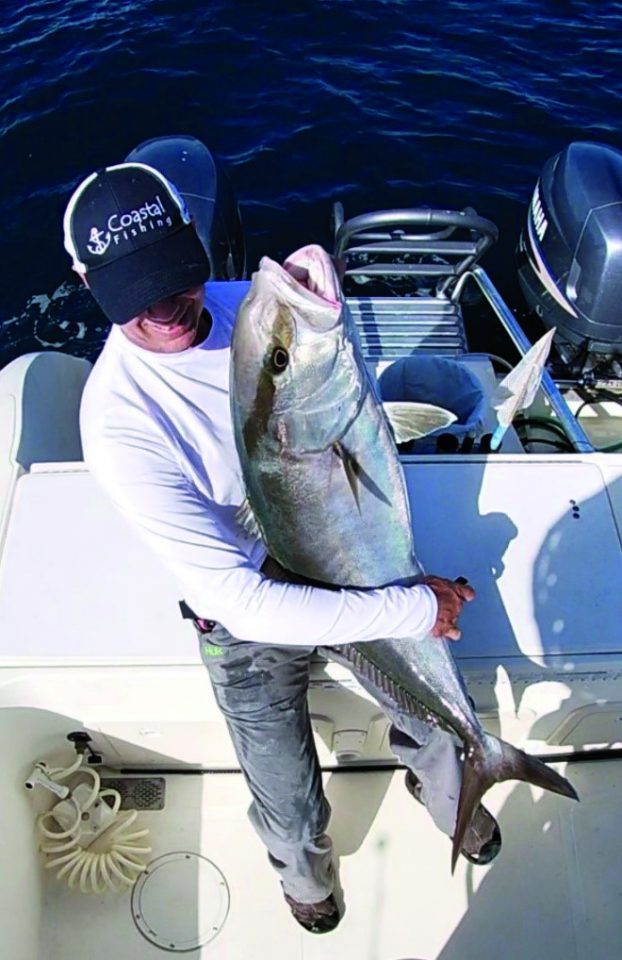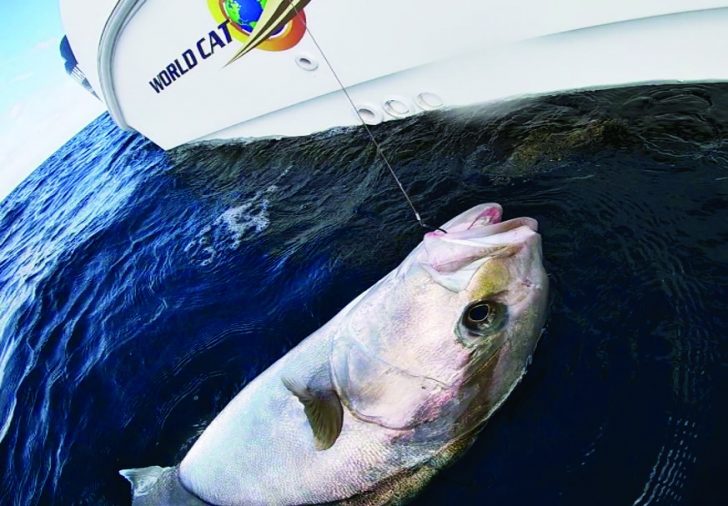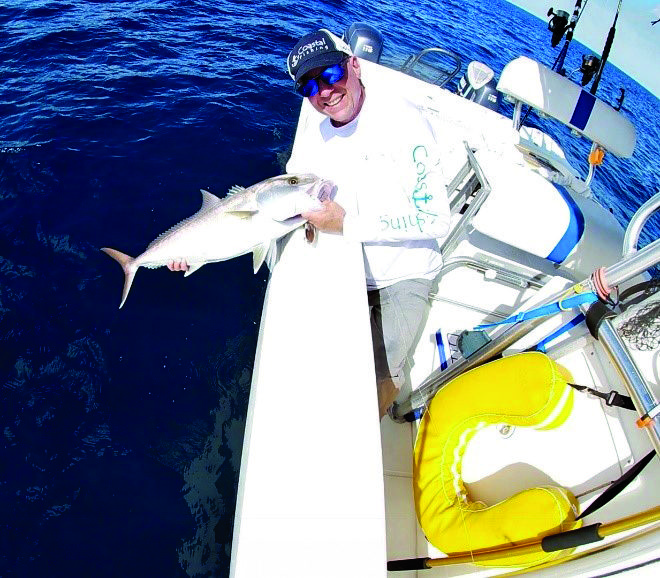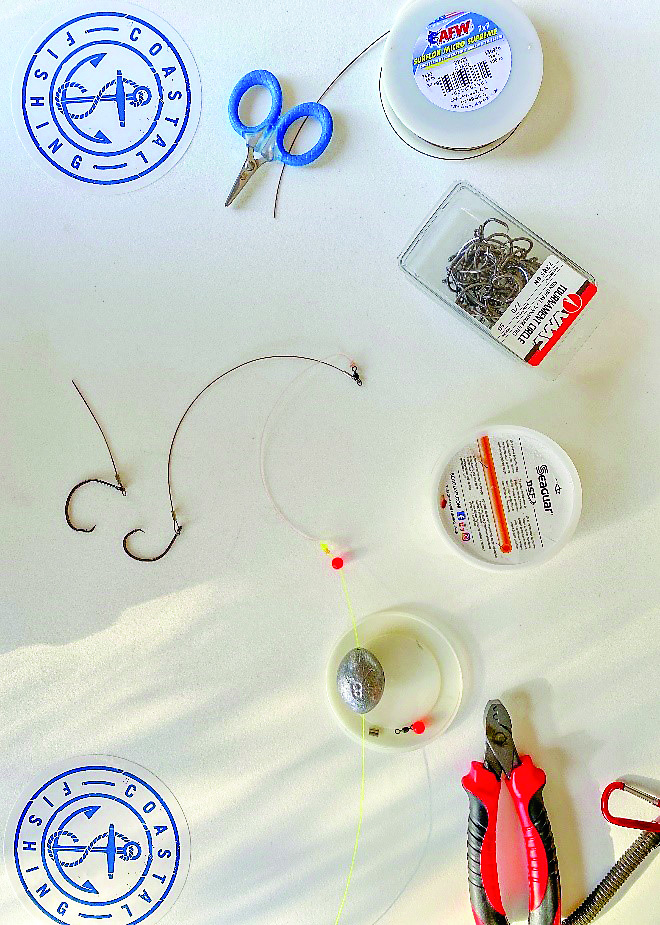By Mark Ambert Contributing Writer

There are times when I just want to get out and try something different. Sometimes it occurs when I’m already on the water and the current plan is just not working. Whether it’s because the bites not happening or you just want to target something different; species like amberjacks, barracuda, and even sharks can bend the rod and bring a smile – saving an otherwise slow day. When the targeted species are not cooperating, fish like the amberjack or “aj” are always willing if they can be found.
In this article, I’ll highlight catching the sometimes overlooked “reef donkey” or amberjack as a targeted gamefish. Ajs are notoriously strong fighters and can really challenge an angler’s skill when they reach a certain size – thirty pounds plus. Typical sizes for this fish on the wrecks and reefs are 30 to 60 pounds but can reach epic proportions at over 100 pounds! The Florida state record is a whopping 142 pounds. If you hook up to one of these – hang on! Schools of young fish are common at 5 – 20 pounds.

Pro Tip – In the case of amberjacks, the small ones can be excellent table fair if prepared and eaten the same day. The larger ones up to a certain point (30 – 40 pounds) are excellent when smoked. Just don’t take the meat closest to the tail, where parasites may occur. Trim and clean them accordingly and remember while unsightly – these parasites are benign.
When targeting these fish, I typically prefer the deeper wrecks and reefs in the 200 – 250 feet range as this helps avoid the problems with your catch being eaten by a shark. To target these strong fish at these depths, you’ll need a stout setup. I recommend a 6’6” rod with a soft tip to “see” and feel the baits movements, but with a powerful butt section to do the heavy lifting. The rod should have a forgiving power curve to absorb the punishing battle that will ensue. It should be light in the hands to reduce angler fatigue. I’m collaborating on a new series of rods called the Enthusiast Series™ that perfectly meets these requirements – stay tuned.

For the reel, I recommend the Shimano Talica-II 2 Speed Lever Drag Reel. It will hold 725 yards of 65-pound braid while providing 45 pounds of max drag pressure. The 2-speed really comes in handy when a big fish digs in and won’t give up on the bottom. I spool mine with 65 pound Power Pro Braid in Moss Green and a top shot of 50 yards of 50 pound Momoi Mono. The mono top shot is key in that it stretches and absorbs some of the stress during a protracted battle.
The leader is the most vulnerable aspect of your fishing system. Make sure to get it right and use only quality components fighting these fish, you won’t get a second shot at that trophy! I’ve had big amberjacks straighten 4X strong VMC tournament grade hooks in their bid for freedom.
Insurance policy against toothy critters – 65 pound Surflon nylon coated 24” leader in camo secured with a size 4 crimp to a VMC size 8/0 circle hook and a quality 150 pound barrel swivel.
To complete your leader setup – two pulls across the chest (roughly 10’) with 50 pound Seaguar fluorocarbon attached to the Surflon wire leader. This is attached to the main running line. The barrel weight is secured above this attachment on the main line using a double uni knot and safety bead to keep the weight from rubbing against the knot (see pic).

Pro Tip – I like the fluoro for its extreme abrasion resistance should you hook a nice grouper that tries to get away.
To start the day, I review my local fishing maps to plan. I highly recommend Home Port Charts, based in Stuart Florida. These maps give you all the information needed to locate productive local reefs and wrecks and at the desired depth
s. You can also check the Florida Fish and Wildlife website for the most up-to-date locations of artificial reefs. Map out two or three different locations that represent various structure, depths, and locations. This will give you choices as the day and conditions unfold. I particularly like fishing wrecks on slow or no current days. These days can be tough due to the lack of current balling up bait. Wrecks and reefs will always hold some bait and even the smallest amount of current will stack bait around structure. Slow current days will keep you on your target longer into your drift.
When the current becomes too strong to make a smaller wreck feasible, switch to a targeted reef system where you can maintain a longer drift over structure. I very rarely anchor for this type of fishing.
Pro Tip – Many times, the larger fish will sit down current of the structure you are fishing as the bait gets swept along with the current, so be sure to drift well past the reef or wreck you are exploring. The stronger the current, the farther away the bait will be from the structure.
Set up your drift on the upside of the structure based upon current and wind conditions. You’ll need at least 8 ounces of lead to get your offering down to the bottom. Plan on having 6, 8, 16 and 32 ounce weights. I go as light as possible to maintain my position close to structure. You want the line as close to straight up and down below the boat as possible as you drift. This is when slower current really works to your advantage for this type of fishing. Once your weight touches structure, reel up two or three full cranks of the reel. Set your drag to “fighting” position with approximately 20 pounds of drag pressure. Set the rod in a gunnel holder and watch the tip of the rod. A sensitive tip will telegraph the baits movement and tell you when it’s nervous just prior to being eaten. When the tip bounces, do not pick up the rod! Wait until the drag engages and line is peeling from the reel – fish on! Not having to set the hook but rather letting the line come tight is just one benefit of circle hooks. Most all fish will be hooked in the jaw for easy catch and release. Make sure to check updated regulations on the use of acceptable bait hooks. For certain anglers it may be easier to just leave the rod in the holder and fight it from there – especially on the bigger fish. Only remove the rod when the fish tires and is brought boat side to facilitate landing. I like to do this on large fish and pick up the rod just before the top shot leader comes thru the rod tip. Note – I like a lightweight roller tip-top to prevent the knots from getting caught on the tip guide under pressure.
I find that structure-oriented fish are active most of the day and thru most of the tide changes. If anything, other elements such as cold fronts, barometric pressure or moon phases will affect the bite more.
Just remember – most anglers fish when they can vs. optimal conditions – so go out, enjoy the day, and have a backup plan! Whether it’s a client, friend or family member looking to “bend a rod” these fish can save an otherwise nonproductive fishing trip and be great alternatives for putting a smile on and having a successful day. And who knows – you may also hook into one of the many trophy sized grouper that frequent these same wrecks and reefs!
Mark Ambert – Avid outdoorsman, sportswriter & photographer
Follow me on Instagram @marksgonefishing or contact me at marksgonefishing@gmail.com for collaboration
